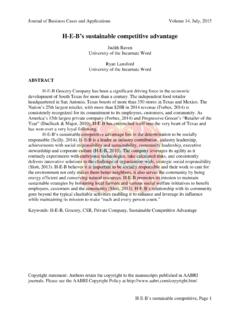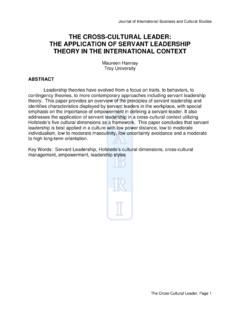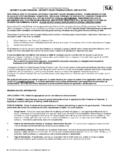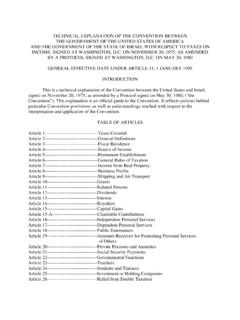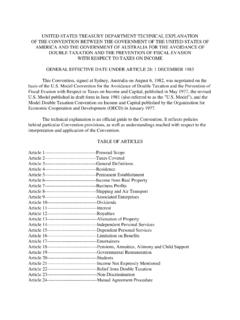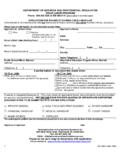Transcription of The moral hazard of mandatory membership in private clubs
1 Research in Business and Economics Journal The moral hazard , page 1 The moral hazard of mandatory membership in private clubs Leon Hoke The University of Tampa Brian T. Kench The University of Tampa Charles Skipton The University of Tampa ABSTRACT There is a trend sweeping the private club industry in Florida, mandating that all homeowner association members pay initiation fees and dues to the private country club in their housing development. So-called mandatory membership fees are an attempt to eliminate, or at least reduce, a free-rider problem concerning the financial health of ailing private country clubs . This paper argues that the implementation of mandatory memberships creates a moral hazard problem. Because of mandatory memberships, homeowners now have little to no protection from the board of directors and staff of the country club that might be interested in empire building or promoting salary and benefits increases while forcing homeowners in the housing development to pay the tab.
2 Finally, the authors offer an explanation of how this mandatory membership moral hazard may actually lead to decreases in property values and rent transfers among the participants. Keywords: agency theory, common interest community, mandatory membership , moral hazard Copyright statement: Authors retain the copyright to the manuscripts published in AABRI journals. Please see the AABRI Copyright Policy at Research in Business and Economics Journal The moral hazard , page 2 2 INTRODUCTION There is a trend sweeping the private country club industry, mandating that all common interest association members pay initiation fees and dues to the private country club in their private community. In many cases, private country clubs have fallen on hard times and are threatening to go bankrupt, thereby negatively affecting housing values in the housing development. The argument made by the private golf clubs for mandatory membership fees is that as housing values in the development surrounding the golf course are positively impacted by the success of the golf club so should all of the home owners within the community contribute financially to the well-being of the private country club.
3 Hence, mandatory membership is an attempt to eliminate, or at least reduce, an individual home owner s incentive (within the housing community possessing the golf club) to let someone else pay for the costs of these ailing clubs . In the jargon of economics, mandatory membership is an attempt to eliminate a free-rider problem where the public good is the golf club (with its manicured greens) and the non-excludable parties (who benefit from the positive externalities created by the club) are the proximal property owners within the housing development. In short, the argument for mandatory membership is one which endeavors to bring an efficient level of golf course / club provision to a market where the potential for under provision exists. Though economic efficiency arguments for mandatory membership contracts suggest their use in some cases, they can have a dark side. mandatory membership fees create a moral hazard problem where the interests of the principal (both the home owners and the private owners of the club) are no longer in line with those of their agents (both the board of directors, hereafter BOD, and staff of the club).
4 Once mandatory membership is in place, the principals have little to no protection from a BOD and staff whose personal interests may be empire building, while the home owners pay the These issues, along with an explanation of how the potential for the moral hazard problem may actually lead to decreases in property values and rent transfers among the various participants, are addressed here. The next section reviews the common interest community governance structure and its treatment by courts. Section three lays out the current state of the golf industry. Section four introduces the concept of mandatory membership to a country club and how the Court has treated such contracts. Section five argues that mandatory membership programs are a poor organizational design mechanism to solve the financial problems of country clubs . The last section concludes the paper. 1 Empire building describes the actions of decision makers to maximize the size of their division s budget, number of employees, size of facility, etc.
5 , instead of maximizing its profits (or minimizing its costs). Such behavior is often suggested to occur whenever decision makers are neither residual income claimants nor compensated in some fashion which explicitly aligns the interests of the principal and the agent. In the public choice literature, which studies government decision making, the study of such behavior is called bureaucracy theory (see Niskanen, 1996). Research in Business and Economics Journal The moral hazard , page 3 3 COMMON INTEREST COMMUNITY GOVERNANCE More than 62 million American live in common interest communities in which owners of separate real estate parcels have some common interest that is owned and managed by a Drewes (2001, ) writes that common interest communities attract investors because they (1) seem to provide traditional services such as trash collection more efficiently than a local government, (2) enable an investor to acquire private access rights to golf courses, tennis courts, and other amenities that otherwise they otherwise could not afford, (3) efficiently regulate conduct within the boundaries of the community, and (4) foster a belief by investors that such restrictive regulations and other services provided ensure that property values will remain high.
6 Examples of common interest communities include gated communities, condominium associations, and cooperatives. More formally, property law defines a common interest community as: A real estate development or neighborhood in which individually owned lots or units are burdened by a servitude that imposes an obligation that cannot be avoided by nonuse or withdrawal (a) to pay for the use of, or contribute to the maintenance or, property held or enjoyed in common by the individual owners, or (b) to pay dues or assessments to an association that provides services or facilities to the common property or to the individually owned property, or that enforces other servitudes burdening the property in the development or Common interest communities have restrictive covenants4 or constitutions that are tied to land and are enforceable against the initial owner entering into the contract and the covenant is also tied to any future owner of the property. All current and future land owners in a common interest community must agree to abide by the benefits and burdens of the communities restrictive covenant.
7 Common interest communities are organized around community associations. Most commonly, community associations are governed by an elected BOD. In this setting, the governance mechanism requires homeowners to join the community association and then hand over the control of the community to the governing body. This organizational model places homeowners in a similar situation to that of shareholders in a large corporation; residents are freed from management worries and are able to sit back and watch their property values grow. On the rare occasion when a covenant issue arises in the common interest community, a full referendum among all the members of the community is called. Otherwise, the day to day governing matters are left to the governing body to vote on the level of services delivered and internal assessments. The BOD typically hires an independent management team to manage the day to day management affairs, , hiring security and collecting association dues, of the common interest community.
8 Nelson (2002, 66) writes that the residents of a community association choose the members of the BOD through an election. The terms of members are usually staggered so that only part of the BOD is elected at any given time. Candidates generally run as individuals 2 See (last visited May 9, 2012). 3 Restatement, third, of Property, Servitudes, Section , (2000). 4 Covenants are also called Declarations of Covenants, Conditions, and Restrictions (CC&Rs). Research in Business and Economics Journal The moral hazard , page 4 4 without any party labels. A typical term might be two or three years. Most elections are at large; all the candidates run against one another and the highest vote getters win the allotted number of seats on the BOD. In the normal arrangement, voting rights in community elections are assigned equally to each housing unit. Hence, multiple owners of single units must share a single vote, and renters usually do not have any vote at all.
9 Once elected, the BOD will normally have its own voting rules that apply for the standard kinds of decisions it handles, and it usually operates by majority rule. All common interest communities are private organizations. As such, a community association has the power to modify existing or add new community bylaws. Because these communities are private organizations, courts generally show deference to their internal activities and to the decision-making and rule-making functions served by community associations (Rogers 2004, 1457). However, if a disagreement over the common interest community s covenant or bylaws develops, then the courts are called upon to resolve the matter. In adjudicating these matters, courts have adopted a variety of approaches to balance the interests presented by the parties; the most common of which is contract law because the covenant is a contract tied to land (Rogers, 1458). Matters commonly brought to the court address cases where a BOD (1) assiduously enforced covenants of which many residents were unaware (despite having signed the covenant upon their purchase and sale) and (2) promulgated restrictive new policies without the input of most residents (Drewes 2001, 322).
10 As for the first matter, a strict view of contract law suggests that investors should be bound by the contract they explicitly sign, no matter whether the investor fully understood the contract at the time of its signing. The most cited legal example of the view is the following: [Covenants, conditions, and regulations (CC&Rs)] are clothed with a very strong presumption of validity which arises from the fact that each individual unit owner purchases his unit knowing of and accepting the restrictions to be Although case law has applied the word "reasonable" to determine whether such restrictions are valid, this is not the appropriate test, and to the extent that our decisions have been interpreted otherwise, we disagree. Indeed a use restriction in a declaration .. may have a certain degree of unreasonableness to it, and yet withstand attack in the courts. If it were otherwise, a unit owner could not rely on the restrictions found in the declaration of condominium, since such restrictions would be in a potential condition of continuous ,6 This commonly cited precedent set by Hidden Harbour supports a hands-off judicial policy by the Court.



